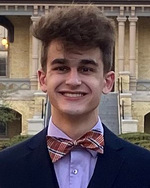2022 Slatt Scholars

Evan Bursch
High-Order Implicit Shock Tracking For Inertial Confinement Nuclear Fusion
Department of Aerospace and Mechanical Engineering
Faculty Advisor: Ryan McClarren
This project aims to advance the field of inertial confinement fusion research, specifically by applying high-order implicit shock tracking (HOIST) to inertial confinement fusion modeling problems. This novel computational method has proven to provide improved efficiency and accuracy in a variety of discontinuous shock tracking applications. Specifically, the goal of this project is to demonstrate that the radiation hydrodynamics system used in inertial-confinement fusion modeling can achieve high-fidelity with reduced computational cost by utilizing HOIST. This research supports the ND Energy research area of sustainable and secure nuclear energy, providing a refreshing new dimension to the current fission-centered program. Nuclear fission is a necessary and worthwhile form of renewable energy, but it possesses challenges related to safely disposing of waste products, negative public perceptions, and the potential for catastrophic events. While no power source is without risks, nuclear fusion is by far the most low-risk, high-reward option available to humanity. If nuclear fusion ignition can be achieved followed by cost-effective power production, fusion can solve the numerous problems associated with the current renewable energy scheme. This research project will contribute to this goal by advancing the accuracy and efficiency of the current inertial-confinement fusion shock tracking model.

Caitlyn Cano
Radium Analysis of Natural Samples from Laguna Pueblo
Department of Civil and Environmental Engineering and Earth Sciences
Faculty Advisor: Peter C. Burns
The Jackpile Mine in western New Mexico was once the world’s largest open-pit uranium mine— but now only serves as a serious health hazard and financial burden to the Laguna Pueblo Native American tribe. One of the tribe’s primary concerns for the area is radium contamination in the subsurface, which in turn could leach into the Rio Paguate (a primary water source for the community). Researchers at the University of Notre Dame and the University of New Mexico are working towards surmounting sufficient evidence to appeal to the Environmental Protection Agency for more aggressive remediation efforts. In the radium analysis portion of the project, we will use natural samples collected on a recent trip to the mine site to determine the severity of radium contamination. Soil and mud sediments as well as organic matter will be analyzed in the lab for radium content, and if significant amounts are detected, the data could be used as evidence to call for further research into radium and uranium movement through the subsurface. Depending on the findings in the radium detection experiments and our structural understanding of the samples’ compositions, we can provide a more compelling argument for urgent efforts towards remediating nuclear waste in the region. Uranium mining is a critical step in the nuclear fuel cycle, and understanding the long-term environmental consequences at the Jackpile site will contribute to a broader goal of developing sustainable nuclear fuel practices.

William Cheong
1,3,5 Trithiane as a Sulfur Source in Metal Sulfide Nanoparticle Synthesis
Department of Chemistry and Biochemistry
Faculty Advisor: Emily Tsui
Metal sulfide nanoparticles are of great interest due to their photo- and electrochemical properties. Although there are many methods to synthesize metal sulfide nanoparticles, there is a lack of comprehensive understanding on the reaction mechanisms. For example, the use of thiols or organic disulfide compounds requires the cleavage of C−S bonds. Comparison of different organic sulfur precursors may elucidate the high temperature nanoparticle formation mechanism. Previous research has involved the synthesis of FexSy and CdS nanoparticles using different sulfur precursors, including the thioformaldehyde equivalent 1,3,5-trithiane. Understanding the mechanism of how 1,3,5-trithiane interacts with solvents at high temperatures to form metal sulfides may lead to the development of improved and more selective synthetic procedures.
This project will focus on studying the mechanism of formation for metal sulfide nanoparticles. In particular, experiments will quantify the release of H2S, a well-documented reactive species in nanoparticle formation, from various sulfur sources. Previous papers have cited the possible importance of C-S bond strengths in disulfides, which may have an influence on the phase of metal sulfide nanoparticles formed. The strength of the C-S bond may impact the release of H2S or some other reactive sulfur species. This project proposes to perform molecular studies of 1,3,5 trithiane decomposition to identify reactive species formed in situ. For example, NMR experiments will investigate the release of H2S from 1,3,5 trithiane in the presence of an amine (p-toluidine). From this research, we hope to gain a better picture of the mechanism of formation for metal sulfide nanoparticles. The goal of this research is to contribute to the general understanding of metal sulfide nanoparticle synthesis and lead to better, more controlled synthetic routes.

Robert Crawford
Life Cycle Assessments of Building Materials in Notre Dame Construction
School of Architecture
Faculty Advisor: John Onyango
New construction represents one of the greatest challenges in our struggle against climate change, but also a key leverage point which, when navigated correctly, could prevent energy waste and emissions worldwide. By itself, the energy required to construct a building is immense, but the implications of that building’s energy usage over its entire life-cycle are just as relevant. Designers and project owners—especially those interested in green building and concerned with issues such as global warming—often use life-cycle assessments to ensure their project represents as little of a threat as possible to the environment. A life-cycle assessment (LCA) is a method for measuring the effects that a building or a specific material or product has on the environment over its entire life cycle, from production to the end of its use. LCAs are intrinsically tied to energy usage, both the embodied energy required to produce materials and buildings as well as the energy saved or wasted by materials and buildings over their lifetime. Knowing which products demand the least energy and allow for the most energy-efficient building designs is integral in understanding how to reduce greenhouse gas emissions. By reducing our energy demand and emissions on campus, the University of Notre Dame can establish itself as a leader and a model in the climate change crisis.
The goal of this project is to perform life-cycle assessments for different materials used in the construction of campus buildings and determine which option is most environmentally viable. Research will be done initially to determine which buildings are the most appropriate to study, taking into account the materials that have previously been used in the university’s construction as well as alternatives that could potentially be used to reduce energy usage and emissions. After that information is gathered, SimaPro software will be used to conduct life-cycle assessments for each material. The data collected will be shared with the university to encourage more sustainable building practices and materials.

Vincent DiFilippo
Optimization of Noise Reduction of a Propeller Using Microfiber Coating for Wind Turbine Applications
Department of Aerospace and Mechanical Engineering
Faculty Advisor: Hirotaka Sakaue
To further advance wind power technology, this research focuses on the noise-reduction characteristics of applying a microfiber coating to a propeller. The microfiber coating is made of small fibers attached to an adhesive layer that can be applied to the surface of a propeller blade. By applying the microfiber coating to different locations along the leading or trailing edges of a propeller blade, the flow characteristics are changed and the noise generated by a propeller can be reduced. Since the microfiber coating is a passive flow control, it could provide great benefit to people who live near wind turbines at a low cost. Capturing sound level reduction values for microfiber coating applied at different locations on the propeller could grant insight into fundamental flow physics and could be scaled to a full wind turbine with reduced noise.
Vincent DiFilippo Final Report

Gavin Ealey
Photoinduced Charge Transfer Processes with AgInS2 Loaded in Bipolar Membrane (BPM)
Department of Chemistry and Biochemistry
Faculty Advisor: Prashant V. Kamat
Bipolar membranes (BPMs) have continued to gain attention due to their applications in electrolysis and photoelectrolysis. The membrane consists of a sandwiched anion exchange layer (AEL) and cation exchange layer (CEL) which allows for loading of anionic and cationic species respectively. The BPM matrix offers an excellent opportunity to embed a photocatalyst (AgInS2) and a metal catalyst selectively in CEL and AEL. This project will seek to synthesize AgInS2 in the BPM matrix via cation exchange in the CEL. AgInS2 does not contain heavy metal ions and demonstrates excellent photocatalytic properties. These photocatalytic properties will be utilized to harness light energy to create chemical energy via H2 generation. H2 generation has shown significant strides as increasingly efficient for light energy utilization and is an area of study found to be incredibly worthwhile by the Kamat Lab.
To do this, the photoactive BPM will be synthesized by soaking it in silver solution to allow loading of Ag+ in the CEL. The film will then be washed and dipped in thioacetamide (TAA) to form Ag2S. To get the desired AgInS2, the film will be put in indium acetate dissolved in oleylamine and allowed to cation exchange. Silver ions (Ag+) already in the membrane will be exchanged with Indium ions (In 3+ ) present in the solution. By varying time, membranes with different ratios of Ag/In will be obtained. Consequently, the resultant film will be exposed to AuCl4-, gold precursor. AuCl4- will preferentially be loaded on the AEL side of the BPM owing to its net negative charge. With the photoactive membrane, it will be possible to probe electron transfer to ethyl viologen (EV2+ ) under steady state photolysis.

Matrika Franklin
Ugandan Wind Turbine
Department of Physics
Faculty Advisor: Abigail Mechtenberg
The goal of this project is to explore wind turbine basket woven blades made by the local “weaving women” in Uganda from Fort Portal to Kampala. A successful model of such a turbine has tested in both places, but now the question is whether the logistics will allow a wide scale implementation of such a device to be pursued, and whether the impact will be an improvement from the current energy crisis interventions. Continuing the work of Prof. A.R. Mechtenberg, J. Brown, and other contributors, this project plans to complete the data collection using Vernier Structures & Materials Tester, modeling in Python and MATLAB, and experimental analysis of the Ugandan Wind Turbine systems installed.
The motivation behind this research is to investigate the engineering design trade-offs between economic, maintenance, social, and environmental variables. By utilizing the production of blades locally the need for expensive, locally unmaintainable/unsustainable blade materials, financial and environmental cost of shipping, and the outsourcing of skilled engineers from overseas western countries, can be minimized. The end goal is to publish the results in an Engineering Design academic journal.

Nathaniel Hiott
Electron Transfer Processes in Two-Dimensional Lead-Halide Perovskites
Department of Chemistry and Biochemistry
Faculty Advisor: Prashant V. Kamat
Lead-halide perovskites are an important part of the emerging field of next-generation semiconductors and solar cells. Two-dimensional perovskites exhibit superior photophysical properties, environmental stability, and bandgap tunability to their three-dimensional counterparts. This research project seeks to expand our understanding of the photophysical properties of two-dimensional lead-halide perovskites and their interactions with solvents of different polarities and with electron acceptors such as fullerene. This research will open new opportunities for exploring the photocatalytic applications of two-dimensional perovskites.
Previous work with the Notre Dame Radiation Laboratory experimented with two-dimensional lead-bromide perovskites to determine if electron transfer could be induced between the perovskite and another material. This research suggested that electron transfer does occur between the excited perovskite and fullerene. However, the experiments need to be repeated using 2D lead halide perovskites of different layer thickness and halide composition. By varying the elemental composition of this precursor solution, it is possible to synthesize lead-bromide and lead-iodide perovskites of one-, two-, and three-layer thickness. Their excited state behavior can be elucidated by testing the fluorescence of these samples as fullerene is added and other electron acceptors, or as solvents of variable polarity are added including acetone, acetonitrile, and ethanol. This project aims to use the results of these experiments to confirm that electron transfer does occur between lead-halide perovskites and electron acceptors, to determine acceptable solvents that can be added to the 2D perovskite in solution, and to inform further research into the viability of two-dimensional lead-halide perovskites in solar cells and photocatalysis.

Grace Hsu
Synthesis and Characterization of Uranyl Borosulfate Compounds and U(IV)/U(VI) Oxalate Compounds
Department of Civil and Environmental Engineering and Earth Sciences
Faculty Advisor: Peter C. Burns
This project will focus on the synthesis of uranyl borosulfate compounds and U(IV)/U(VI) oxalate compounds. After these materials are made, they will be characterized using a variety of methods such as single crystal and powder X-ray diffraction, infrared and Raman spectroscopy, and thermogravimetry analysis.

Jiaqi Lu
Automated Prediction of the Viscosity of Ionic Liquids Using Transfer Learning
Department of Chemical and Biomolecular Engineering
Faculty Advisor: Yamil J. Colón
Rare earth elements are essential to clean energy, electronics, industrial application, aerospace, and so on. The extraction of rare earth elements often involves liquid-liquid extraction using ionic liquids (ILs). For liquid-liquid extraction, IL with low viscosities are preferred, but there is limited data on the viscosity of numerous ILs. Determining the viscosity of ILs can offer valuable insights for designing ILs for extraction of rare earth elements. However, little research has been conducted in predicting their viscosity. While there are numerous ILs, machine learning can be used to boost the efficiency of prediction. Since the nature that relates density to viscosity are similar, we hypothesize that transfer learning can use the relatively large dataset of IL density to train models to predict density, which can then be applied to predict viscosity based on the relatively limited data on viscosity. Previous research has applied Extreme Learning Machine to predicting IL viscosity, a fundamentally different method from transfer learning, which retains the uniqueness of the proposed approach. Meanwhile, a published database containing the viscosity of 1484 ILs, although not extensive, can serve as validation data points for the model.

Laura Manukyan
Synthesis of Organometallic-Functionalized ZnO and TiO2 Nanocrystals for Photocatalysis
Department of Chemistry and Biochemistry
Faculty Advisor: Emily Tsui
Colloidal semiconductor nanocrystals are useful for a wide variety of applications such as displays and photovoltaics due to their strong light-absorbing properties. One such application of nanocrystals is photocatalysis – a process in which light absorption forms an excited electron-hole pair that can be used for substrate reduction or oxidation. As such, nanocrystals have been targeted for energy-related transformations such as solar fuels applications. Among these reactions, although hydrogen evolution using nanocrystal photocatalysts is well studied, multi-electron/proton reactions such as N2 or CO2 reduction have proven to be more challenging.[1],[4] Possible candidate materials for these transformations are metal oxides like ZnO or TiO2 nanocrystals that have been demonstrated to be able to accumulate multiple electrons and to also act as proton-coupled electron transfer reagents.[2],[3]
This research project will use organometallic-functionalized ZnO and TiO2 nanocrystals as the proposed photocatalysts. Here, the metal oxide NCs will serve as the photosensitizers, while the attached organometallic fragments will act as the catalytic active sites. Previous work has synthesized ZnO nanocrystals and the functionalization studies with ZnO-ZnFe(CO)4 have begun. After completing the synthesis and characterization of the ZnO-ZnFe(CO)4 nanocrystals, the next objectives will be to do the same functionalization and characterization chemistry on TiO2 nanocrystals as well. Next, this research project will aim to study these systems for stoichiometric reactions. This probes the question of if these systems can be used for electron and proton transfer to the Fe center. Lastly,the project will try to turn these systems to photocatalytic reactions. It is hypothesized that putting organometallic species onto the surfaces of metal oxide nanocrystals can then enable improved photocatalytic reactions for CO2 and N2 reduction.
(1) Burke, R.; Bren, K. L.; Krauss, T. D. Semiconductor Nanocrystal Photocatalysis for the Production of Solar Fuels. J. Chem. Phys. 2021, 154, 030901.
(2) Valdez, C. N.; Braten, M.; Soria, A.; Gamelin, D. R.; Mayer, J. M. "Effect of Protons on the Redox Chemistry of Colloidal Zinc Oxide Nanocrystals." J. Am. Chem. Soc., 2013, 135, 8492−8495.
(3) Schrauben, J. N.; Hayoun, R.; Valdez, C. N.; Braten, M.; Fridley, L.; Mayer, J. M. Titanium and Zinc Oxide Nanoparticles Are Proton-Coupled Electron Transfer Agents. Science 2012, 336 , 1298–1301.
(4) Schimpf, A. M.; Knowles, K. E.; Carroll, G. M.; Gamelin, D. R. "Electronic Doping and Redox Potential Tuning in Colloidal Semiconductor Nanocrystals." Acc. Chem. Res. 2015, 48, 1929-1937.

Zachary W. Muetzel
3D-Printed Crossflow Diafiltration Modules for the Recovery and Recycling of Critical Materials
Department of Chemical and Biomolecular Engineering
Faculty Advisor: William Phillip
Society is becoming increasingly reliant on the use of batteries in a variety of applications, but the natural supply of many raw materials required for battery production cannot satisfy the demand. Consequently, for production of the widely used lithium-ion battery to scale with increasing demand, recycling of these batteries, and more specifically the raw materials they contain, will be necessary. At present, cobalt (Co) is the most expensive product of lithium-ion battery recycling, while lithium (Li) is quickly becoming more desired as the supply of natural lithium decreases. Today, harsh solvents are often used in Li/Co separations, which produce toxic byproducts and have unwanted environmental impacts. Fortunately, emerging membrane materials have shown promise as an alternative method in accomplishing this separation because of their flexibility and selectivity.
Clever systems design will be required in conjunction with advances in membrane materials to accomplish this challenging separation. Guided by this information, a fellow undergraduate researcher, Cara Kilmartin, developed a model for a single stage diafiltration module (Industrial & Engineering Chemistry Research, 2021, 60, (43)). The model was experimentally validated using a physical apparatus. The resulting ADD: Acquisition of Dynamic Data device is detailed in a paper that was just submitted for review. The ADD device relies on a combination of commercial hardware and custom 3D-printed parts. Specifically, in addition to modeling the performance of a single stage system, Kilmartin et al. extrapolated the results to identify the enhanced performance that can be realized by connecting diafiltration modules in series (i.e., by creating a multi-stage cascade). At present, there is no experimental apparatus available to probe the performance of multi-stage designs.
The objective of the proposed research is to create crossflow diafiltration cascades that take advantage of the favorable properties of staging and controlling flows to increase the separation efficiency and advance the state-of-the-art in the separation of lithium and cobalt. The created device will be made up of one unit, or stage, that can be combined in sequence with identical units to achieve the desired separation. By allowing identical stages to connect to one another, the cascade has the advantage of having less parts and therefore being easier to produce and repair. Using mathematical models, fluid dynamics simulations, and additive manufacturing in an iterative feedback loop, a novel unit design can be created to maximize the separation efficiency and membrane testing capabilities it possesses.
Zachary W. Muetzel Final Report

Jeff Mwathi
Testing Sub-2 nm Fe Nanoparticles on Graphene for the Oxygen Reduction Reaction
ND Energy
Faculty Advisor: Ian V. Lightcap
The Lightcap lab has developed a technique to grow sub-2 nm Fe particles on reduced graphene oxide (RGO). Iron oxides have been proposed as possible earth-abundant catalysts capable of replacing platinum in hydrogen fuel cells. However, very short hole diffusion lengths have limited their performance as catalysts. The very small size of the Fe nanoparticles grown in this project (smaller than the hole diffusion lengths), combined with their location on the conductive RGO, may finally succeed in efficiently separating the electron-hole pairs, and thus, improve iron oxide catalyst performance.

Gabriel Pennington
B-Cyclodextrin Polymer Membranes for Adsorption of Organic Micropollutants from Contaminated Water
Department of Chemical and Biomolecular Engineering
Faculty Advisor: Ruilan Guo
Preliminary research has focused on a class of polymer-based membranes that specialize in adsorption of pollutants in contaminated air and water. In particular, beta-cyclodextrin polymers have demonstrated to be promising adsorbents for removing perfluoroalkyl acids from water. These toxic pollutants have been deemed carcinogenic in humans by the USEPA Science Advisory Board and have also been found to cause birth defects and thyroid issues by the National Sanitation Foundation. Most commonly found as perfluorooctanoic acid (PFOA) or perfluorooctanesulfonic acid (PFOS), these anthropogenic contaminants detected in drinking water sources affected by waste releases from industrial facilities and waste water treatment plants. While other bioaccumulative organic pollutants can bind to soil and sediments, these perfluoroalkyl acids are water-soluble and require advanced separation methods to be removed. This research will aim to synthesize functional polymers containing beta-cyclodextrin rings as capturing sites, fabricate these polymers into adsorptive membranes, and identify the physicochemical properties of cyclodextrin polymers (CDPs) that determine their PFA-adsorption efficiencies.

Madison Pixler
Iptycene-Based Polybenzimidazole (PBI) Membrane for High-Temperature H2/CO2 Separation
Department of Chemical and Biomolecular Engineering
Faculty Advisor: Ruilan Guo
When analyzing methods for H2/CO2 separation at high temperatures, current technologies are not sustainable due to high costs, large energy consumption, as well as large toxic solvent consumption. The Integrated Gasification Combined Cycle (IGCC) process that is currently used to synthesize gas to produce energy requires polymer membranes capable of separating the H2 and CO2 leaving the water shift reactor at 100 to 300 degrees Celsius. These high operating temperatures are required for the economic feasibility of the separations as it avoids the cooling of syngas. However, the harsh conditions lead to thermal degradation and decline of separation performance in most commercial polymer membranes. One possible solution is Polybenzimidazole (PBI) Membranes. Unlike other polymer membranes, PBIs are much more thermally and mechanically stable when exposed to high temperatures for extended periods of time. PBIs have very strong interchain interactions through hydrogen bonding which leads to tighter packing, lower free volume, and in turn, lower permeability. By introducing bulky groups such as triptycene or pentiptycene to the PBI structure, it is expected that free volume elements and permeability can be improved. The goal of this research project is to develop a series of novel iptycene-based PBI membranes which exhibits promising gas separation performance at high temperature. This would increase the sustainability of the IGCC process.
The research performed would consist of synthesizing monomers and polymers, casting the films, and conducting permeability tests. It is important to note that hydrogen has high permeability through the membranes while carbon dioxide exhibits strong interactions with the polymer. By constructing a membrane that exaggerates these property differences, the separation of carbon dioxide from the hydrogen can become much more efficient. PBIs have high H2/CO2 selectivity. Commercial PBIs exhibit promising H2/CO2 separation performance but have extremely low permeability due to hydrogen bonding and pi-pi stacking. By introducing the bulky functional groups like iptycene, membrane permeability will increase while decreasing membrane selectivity. These bulky units disrupt chain packing and install configurational free volume elements. Throughout the research process, iterations from monomer to polymer will be completed to film cast to permeability test. This will allow adjustments to the ratio of iptycene added to help fine-tune the desired properties. By introducing iptycene into the polybenzimidazole membranes, the purification of hydrogen can be improved at the high temperatures present in the exiting streams off the water shift reactor in the IGCC process.

Nicholas Poole
Humidity Effects on Metal Uranyl Peroxide Monomers During CO2 Adsorption
Department of Civil and Environmental Engineering and Earth Sciences
Faculty Advisor: Peter C. Burns
This research project has been ongoing since January 2021. Previous research noted that metal uranyl peroxide monomers absorb CO2 from the air if left in the open. The goal of this project is to gain insight into the mechanism by which this occurs. The method to do this involves leaving samples in a humidity chamber and using tools such as Raman Spectroscopy and X-ray Diffraction to analyze their conversion. This work relates to nuclear energy, particularly with spent fuel rods. Radioactive materials can cause water to produce peroxide, allowing for the formation of the uranyl peroxide materials that are being studied. It also relates to CO2 sequestration, where CO2 is captured and stored to be turned into more useful products later.
Project objectives are as follows:
- Continue characterizing the converted materials for sodium, potassium, calcium, and lithium uranyl peroxide monomers, at various humidity levels from 0 to 100% humidity (currently have results for 60%, 75%, and ambient humidity).
- Propose a mechanism by which this occurs in the materials being studied.
- Relate this work to other CO2 adsorbing materials.

Gabriela Roman Perez
Synthesis and Characterization of Nuclear Materials
Department of Civil and Environmental Engineering and Earth Sciences
Faculty Advisor: Peter C. Burns
This project will look at the synthesis and characterization of uranyl materials. The materials to be studied range from natural and synthetic uranium (VI) minerals to uranyl peroxide nanoclusters. Characterization tools that will be used include single crystal and powder X-ray diffraction, scanning electron microscopy, and Raman and IR spectroscopy.
Gabriela Roman Perez Final Report

Tomas Romero
Generating Catalytic Sites Relevant for Cleaner Fuels in Solid-State Materials through Atom-Transfer Chemistry
Department of Chemistry and Biochemistry
Faculty Advisor: Adam Jaffe
The motivation behind this project lies in securing a cleaner energy future by developing methods to modify solid-state materials through previously unexplored means. This would involve using molecular atom-transfer reagents in order to isolate and study catalytic sites within extended solids. More specifically, the research will consist of generating and analyzing metal-oxo and metal-sulfido intermediates relevant for alkane hydroxylation/oxidation and hydroprocessing—important processes for increasing sustainability of fossil fuels. This work also seeks to provide a solid foundation for future projects by developing new methods for material tuning, allowing us to improve existing catalysts and design next-generation materials.

John Joel Sacris
Development of Microkinetic Models for SCR Kinetics in Cu-CHA
Department of Chemical and Biomolecular Engineering
Faculty Advisor: William F. Schneider
Copper-exchanged chabazite(Cu-CHA) zeolites are nanoporous catalysts essential for applications related to energy conversion like partial oxidation of methane or environmental protection like NOx standard catalytic reduction. For the latter reaction, previous computational investigations by the Schneider group, combined with experimental characterizations by the Gounder group in Purdue University, has shown that the catalysis proceeds via a redox interconversion between solvated Cu+ and Cu2+ species hosted within the zeolite framework. Those studies further showed that the mobility of these species is constrained due to ionic tethering by the zeolite framework. Microkinetic models are important computational tools that can bridge together microscopic insights gleaned from these atomistic models with experimental observation. Once parameterized appropriately, these models can motivate design protocols for optimum catalytic performance of SCR on Copper exchanged zeolites.
This research project will employ Ab-initio Molecular Dynamics(AIMD) simulations and Metadynamics sampling techniques to probe the mobility of the solvated cationic species as a function of the reaction temperature and at varied concentrations of other molecular intermediates present during practical SCR conditions. Insights from these simulations can be used to parameterize microkinetic models that can elucidate SCR performance on Cu-CHA across a wide range of reaction conditions and environments.

Yan Saltar
Using Superstructure Optimization Models to Analyze Case Studies for Shale Gas and Sugarcane Processing in the U.S. and Brazil
Department of Chemical and Biomolecular Engineering
Faculty Advisor: Alexander Dowling
The Dowling group specializes in processing modeling, optimization, and economic evaluation of sustainable energy systems. Previous research developed superstructure optimization models with the ultimate goal of determining the best processing routes and chemical products for shale gas upgrading by considering economic, efficiency, and life cycle environmental impact metrics. Previous work included translating spreadsheet technoeconomic calculations from Excel into a library of optimization models implemented in Python. This research project will continue working to use the models to analyze case studies for shale gas and sugarcane processing in the U.S. and Brazil.

Jeffrey Secrist
Characterization of Plasma-Catalysis Systems for Upcycling of Light Hydrocarbons
Department of Aerospace and Mechanical Engineering
Faculty Advisor: David B. Go
This research project aims to develop a greater understanding of plasma and how it can be used in chemical reactions. This research project is motivated by the application of energy and how plasma systems can be applied to increase the efficiency of chemical reactions. Studying methods in which chemical reactions can occur more effectively will allow for applications in energy systems, whether that be producing clean-burning fuels or recycling waste pollutants (e.g., carbon dioxide) from energy processes. Energy efficiency has been and will continue to be a relevant area of study and plasma is a relatively new field of scientific study. This project involves work with a non-thermal plasma reactor studying the chemical transformations of light hydrocarbons and nitrogen. Plasma-enhanced catalysis allows for increased reaction rates and yields that aren’t available elsewhere. Because plasmas are nonthermal, reaction equilibriums can be achieved at different temperatures and pressures. Therefore, studying reactions catalyzed by plasma allows for future energy conservation.

Benjamin Speybroeck
Microporous Polymeric Membranes for Energy-efficient Gas Separations
Department of Chemical and Biomolecular Engineering
Faculty Advisor: Ruilan Guo
Polymeric membranes offer an alternative, energy-efficient technology for many chemical separations. Particularly, polymer membranes have many applications in gas separations, including sweetening of natural gas by removal of CO2 and H2S, production of nitrogen-enriched air, hydrogen recovery, and ammonia purge gas recovery. Although polymer membranes have many advantages (e.g., reduced carbon footprint, low space and weight requirements, and low capital investment), they are challenged by an inherent permeability-selectivity trade-off, low resistance to physical aging and plasticization. The objective of this project is to investigate a new design of polymeric membrane materials that involve shape-persistent structural units to introduce more permanent and stable microporosity in the membranes to enable superior gas separation performance even under harsh conditions (e.g., complex feed mixtures, high temperature). The researcher working on this interdisciplinary project will be trained and explore various aspects of the project including synthesis and polymerization of specifically designed monomers, materials characterization (e.g., thermal and mechanical properties), membrane fabrication (e.g., solution casting, thermal treatment) and gas permeation experiments (e.g., transport properties).
Benjamin Speybroeck Final Report

Alexander Tullman
Electricity Transmission Efficiency Coating
ND Energy
Faculty Advisor: Ian V. Lightcap
Over the last 10 months, previous research has produced good data for the absorptivity, durability, hydrophobicity, and unit economics of the coating. Building off of that research, testing and optimizing the emissivity of the coating is currently taking place. Ovens and a solar simulator are being used to test the ability of a coated piece of aluminum to emit high energy particles faster than a non-coated piece of aluminum. A large factor in achieving this goal has been the modification of the coating and the materials that is used. Barium Sulfate (BaSO4) is currently being integrated into the coating to increase both the emissivity and absorptivity values to make the technology more commercially viable and competitive.

Christina Urrea
Probability Distributions for Electricity Failure - Predicting Points of Chaos
Department of Physics
Faculty Advisor: Abigail Mechtenberg
The unreliability of electricity in healthcare facilities in Lower to Middle Income Countries (LMICs) creates an extra level of risk to the patients being cared for within these facilities. This is demonstrated in Prof. Abigail Mechtenberg’s article on the hidden costs of electricity failure (Mechtenberg et. al, 2020; Mechtenberg et. al 2012). The major research objective is to create a probability distribution to predict the likelihood of when a capacity shortage will occur. With a predicting model, medical personnel working in facilities with unreliable electricity can make more informed decisions. This would decrease the potential loss of life due to failure of life saving machines, delays in treatment, and complications during surgical procedures, as well as improve planning for surgeries and diagnostic testing.
Citations:
Mechtenberg, Abigail, Brady McLaughlin, et al. “Health Care during Electricity Failure: The Hidden Costs.” PLOS ONE, vol. 15, no. 11, Public Library of Science, Nov. 2020, p. e0235760, https://doi.org/10.1371/journal.pone.0235760.
Mechtenberg, Abigail, Kendra Borchers, et al. “Human Power (HP) as a Viable Electricity Portfolio below 20 W/Capita.” Energy of Sustainable Development, vol. 16, no. 2, June 2012, pp. 125–45, https://doi.org/10.1016.